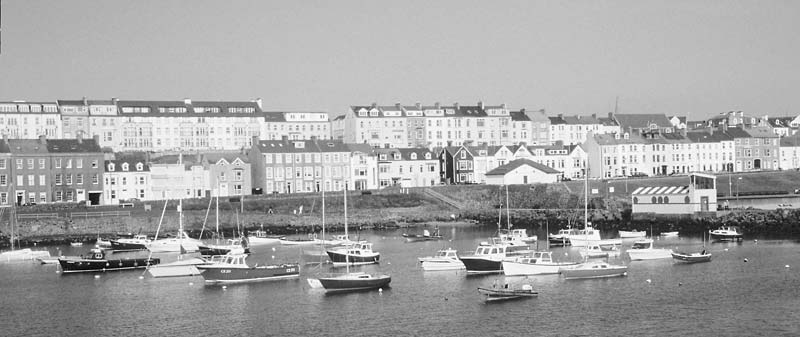
The Antrim Coast—the north of Northern Ireland—is one of the most interesting and scenic coastlines in Ireland. Portrush, at the end of the train line, is an ideal base for exploring the highlights of the Antrim Coast. Within a few miles of the train terminal, you can visit evocative castle ruins, tour the world’s oldest whiskey distillery, catch a thrill on a bouncy rope bridge, and hike along the famous Giant’s Causeway.
You need a full day to explore the Antrim Coast, so allow two nights in Portrush. An ideal day could lace together Dunluce Castle, Old Bushmills Distillery, and the Giant’s Causeway, followed by nine holes on the Portrush pitch-and-putt course. In summer months, the long days this far north extend your sightseeing time (and most golf courses stay open until dusk).
By Car: A car is the best way to explore the charms of the Antrim coast. Distances are short and parking is easy. If time allows, don’t miss the slower-but-scenic coastal route from Portrush to Belfast via the Glens of Antrim.
By Bus: In peak season, an all-day bus pass helps you get around the region economically. The Causeway Rambler links Portrush to Old Bushmills Distillery, the Giant’s Causeway, and the Carrick-a-Rede Rope Bridge hourly (£7/day, May-Sept only, operates roughly 10:00-18:00). The bus journey from Portrush to Carrick-a-Rede (the easternmost point of interest on the route) takes 45 minutes. Pick up a Rambler bus schedule at the TI, and buy the ticket from the driver (in Portrush, the Rambler stops at Dunluce Avenue, next to public WC, a 2-minute walk from TI; operated by Translink, tel. 028/9066-6630, www.translink.co.uk).
By Bus Tour: If you’re based in Belfast, you can visit most of the sights on the Antrim Coast with a McComb’s tour (see here). Those based in Derry can get to the Giant’s Causeway and Carrick-a-Rede Rope Bridge with City Sightseeing (see here).
By Taxi: Groups (up to four) can reasonably visit most sights (except the more distant Carrick-a-Rede) by taxi. One-way from Portrush, it’s roughly £6 to Dunluce Castle, about £8 to Old Bushmills Distillery, and about £11 to the Giant’s Causeway. Try Andy Brown’s Taxi (tel. 028/7082-2223), Hugh’s Taxi (mobile 077-0298-6110), or North West Taxi (tel. 028/7082-4446).
Homey Portrush used to be known as “the Brighton of the North.” It first became a resort in the late 1800s, as railroads expanded to offer the new middle class a weekend by the shore. Victorian society believed that swimming in salt water would cure many common ailments.
This is County Antrim, the Bible Belt of Northern Ireland. When a large supermarket chain decided to stay open on Sundays, a local reverend called for a boycott of the store for not honoring the Sabbath. And in 2012, when the Giant’s Causeway Visitors Centre opened, local Creationists demanded their viewpoint (that, according to the Bible, the earth was only 6,000 years old) be represented beside modern geologic explanations of the age of the unique rock formations...carbon dating be damned.
While it’s seen its best days, Portrush retains the atmosphere and architecture of a genteel seaside resort. Its peninsula is filled with lowbrow, family-oriented amusements, fun eateries, and B&Bs. Summertime fun-seekers promenade along the tiny harbor and tumble down to the sandy beaches, which extend in sweeping white crescents on either side.
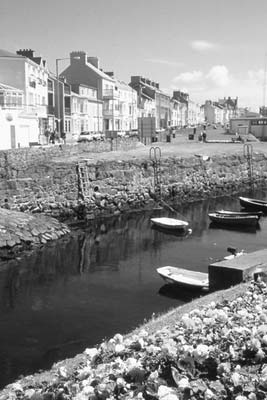
Superficially, Portrush has the appearance of any small British seaside resort, but its history and large population of young people (students from nearby University of Ulster at Coleraine) give the town a little more personality. Along with the usual arcade amusements, there are nightclubs, restaurants, summer theater productions (July-Aug) in the town hall, and convivial pubs that attract customers all the way from Belfast.
Portrush’s pleasant and easily walkable town center features sea views in every direction. On one side are the harbor and most of the restaurants, and on the other are Victorian townhouses and vast, salty vistas. The tip of the peninsula is filled with tennis courts, lawn-bowling greens, putting greens, and a park.
The town is busy with students during the school year. July and August are beach-resort boom time. June and September are laid-back and lazy. There’s a brief but intense spike in visitors in late May for a huge annual motorcycle race (see “Helpful Hints,” later). Families pack Portrush on Saturdays, and revelers from Belfast crowd its hotels on Saturday nights.
The TI is located at the very central, red-brick Town Hall (July-Aug Mon-Sat 9:00-18:00, Sun 11:00-18:00; April-June and Sept Mon-Fri 9:30-17:00, Sat-Sun 12:00-17:00; closed Oct-March; 1 Mark Street, tel. 028/7082-3333). Get the Collins Northern Ireland road map (£5), the free Visitor Attractions brochure, and—if you’re Belfast-bound—a free Belfast map.
The train tracks stop at the base of the tiny peninsula that Portrush fills (no baggage storage at station). All but one (Shola Coach House) of my listed B&Bs are within a 10-minute walk of the train station. The bus stop is two blocks from the train station.
Crowds: Over a four-day weekend in late May, thousands of die-hard motorcycle fans converge on Portrush, Port Stewart, and Coleraine to watch the Northwest 200 Race. Fearless racers scorch the roads at 200 miles per hour on the longest straightaway in motorsports. Accommodations fill up a year ahead, and traffic is the pits (dates and details at www.northwest200.org).
Phone Tips: To call the Republic of Ireland from Northern Ireland, dial 00-353, then the area code without its initial 0, and finally the local number. To call Northern Ireland from the Republic of Ireland, dial 048, and then the local eight-digit number.
Internet Access: Ground Espresso Bar has one coin-op terminal (£1/20 minutes, daily 8:30-18:00, until 22:00 July-Aug, 52 Main Street, tel. 028/7082-5979).
Laundry: Causeway Laundry charges £10/load for full service (Mon-Tues and Thurs-Fri 9:00-16:30, Wed and Sat 9:00-13:00, closed Sun, 68 Causeway Street, tel. 028/7082-2060).
Bike Rental: The recommended Harbour Heights B&B rents sturdy new mountain bikes for £12/day, a great way to experience the gorgeous Antrim Coast.
This is a fine chance to see Northern Ireland at play (open weekends and summer only). Located just below the train station on the harbor, it’s filled with “candy floss” (cotton candy) stands and little kids learning the art of one-armed bandits, 10p at a time. Get £1 worth of 10p coins from the machine and go wild, or brave the roller coaster and bumper cars (July-mid-Sept daily 12:30-22:30; May-June Mon-Fri 10:00-18:00, Sat 12:30-22:30, Sun 12:30-21:30; closed mid-Sept-April; tel. 028/7082-2340, www.barrysamusements.com).
Irish courses, like those in Scotland, are highly sought after for their lush greens in glorious settings. Serious golfers can get a tee time at the Royal Portrush, which hosted the British Open in 1951 and is set to host it again in 2019 (green fees Mon-Fri-£155, Sat-Sun-£175). Those on a budget can play the adjacent, slightly shorter Valley Course (green fees Mon-Fri-£42.50, Sat-Sun-£55). Meanwhile, rookies can get a wee dose of this wonderful golf setting at the neighboring Skerries 9 Hole Links pitch-and-putt range. You get two clubs and balls for £8, and they don’t care if you go around twice (daily 8:30-19:00, 10-minute walk from station, tel. 028/7082-2311, www.royalportrushgolfclub.com).
For some easygoing exercise right in town, this well-organized park offers lawn-bowling greens (£5/hour with gear), putting greens, tennis courts, and a great kids’ play park. You can rent tennis shoes, balls, and rackets, all for £10/hour (mid-May-mid-Sept Mon-Sat 10:00-dusk, Sun 13:00-19:00, closed mid-Sept-mid-May, tel. 028/7082-4441).
Consider Dunluce Centre (kid-oriented fun zone) and Waterworld (£5, pool, waterslides, bowling; June Mon-Fri 10:00-15:00, Sat 10:00-17:00, Sun 12:00-17:00, July-Aug Mon-Sat 10:00-19:00, Sun 12:00-19:00; closed Sept-May; wedged between Harbour Bistro and Ramore Wine Bar, tel. 028/7082-2001).
Portrush has a range of hotels, from decent to ritzy. Some B&Bs can be well-worn. August and Saturday nights can be tight (and loud) with young party groups. Otherwise, it’s a “you take half a loaf when you can get it” town. Rates vary with the view and season—probe for softness. Many listings face the sea, though sea views are worth paying for only if you get a bay window. Ask for a big room (some doubles can be very small; twins are bigger). Lounges are invariably grand and have bay-window views. Most places listed have lots of stairs. All but Shola Coach House are perfectly central and within a few minutes’ walk of the train station. Parking is easy.
To call Portrush from the Republic of Ireland, dial 048 before the local 8-digit number.
$$$ Shola Coach House is a memorable treat that dwarfs mere mortal B&B experiences. A 30-minute uphill walk from town (1.5 miles south), it’s best for drivers. The secluded, 155-year-old, renovated stone structure once housed the coaches and horses for a local landlord. The decor of the four rooms is tasteful, the garden patio is delightful, and Sharon and Dave Schindler keep it spotless (Db-£90-110, Tb-£135, Wi-Fi, parking, tel. 028/7082-5925, mobile 075/6542-7738, www.sholabandb.com, sholabandb@gmail.com).
$$ Adelphi Portrush is a breath of fresh air, with 28 tastefully furnished modern rooms, friendly staff, and a hearty bistro downstairs (Sb-£55-109, Db-£69-109, Tb-£99-139, Qb-£129-169, 67-71 Main Street, Wi-Fi, tel. 028/7082-5544, www.adelphiportrush.com, stay@adelphiportrush.com).
$ Beulah Guest House is a traditional, good-value place. It’s centrally located and run by cheerful Helen and Charlene McLaughlin, with 11 prim and smoke-free rooms (Ss-£33, Sb-£45-60, Db-£60-75, Tb-£85-105, Wi-Fi, parking at rear, 16 Causeway Street, tel. 028/7082-2413, www.beulahguesthouse.com, stay@beulahguesthouse.com).
$ Anvershiel B&B, with six rooms, is a 10-minute walk south of the train station. Jovial Victor Bow, who runs the show with his wife Erna, really knows local golf options (Sb-£45, Db-£65, Tb-£95, Qb-£125, cash only, Wi-Fi, parking, 16 Coleraine Road, tel. 028/7082-3861, www.anvershiel.com, enquiries@anvershiel.com).
$ Harbour Heights B&B rents nine homey rooms, each named after a different town in County Antrim. It has an inviting guest lounge, supervised by two tabby cats, overlooking the harbor. Friendly South African hosts Sam and Tim Swart—a photographer—manage the place with a light hand (Sb-£40-45, Db-£60-80, family rooms, Wi-Fi, bike rentals, 17 Kerr Street, tel. 028/7082-2765, mobile 078-9586-6534, www.harbourheightsportrush.com, info@harbourheightsportrush.com).
$ Portrush Holiday Hostel has 38 beds offering clean, well-organized, economic lodging for bottom-feeding vagabonds (£12.50-15/bed in 10-bed dorm room, £17/bed in 4-bed dorm room, S-£20, Sb-£25, D-£32, Db-£34-38, Qb-£45-55, wash-and-dry laundry service-£6, Wi-Fi, tel. 078/8178-2181 or 078/5037-7367, www.portrushholidayhostel.co.uk, info@portrushholidayhostel.co.uk).
Being both a get-away-from-Belfast and close-to-a-university beach town (Coleraine), Portrush has more than enough chips joints. Eglinton Street is lined with cheap and cheery eateries.
The Scullery is a tiny hole-in-the-wall, making sandwiches and healthy wraps to take away and enjoy by the beach—or on an Antrim Coast picnic (Mon-Sat 9:00-16:00, Sun 10:00-16:00, close to the train station at 4 Eglinton Lane, tel. 028/7082-1000).
Ground Espresso Bar makes fresh £4 sandwiches or paninis, soup, and excellent coffee (daily July-Aug 9:00-22:00, Sept-June 9:00-17:00, 52 Main Street, tel. 028/7082-5979). They also offer coin-op Internet access (see “Helpful Hints,” earlier).
Café 55 Bistro serves basic sandwiches with a great patio view (May-Sept Mon-Fri 9:00-17:00, Sat-Sun 9:00-21:30, shorter hours off-season, 1 Causeway Street, beneath fancier 55 North restaurant run by same owners—listed below, tel. 028/7082-2811).
The Spar Market has what you’ll need for your Antrim Coast picnic (Mon-Sat 7:00-20:00, Sun 7:00-19:00, across from Barry’s Arcade on Main Street, tel. 028/7082-5447).
55 North (named for the local latitude) has the best sea views in town, with windows on three sides. The filling pasta-and-fish plates are a joy (£10-17 plates, daily 12:30-14:00 & 17:00-21:00 except closed Mon Sept-June, 1 Causeway Street, tel. 028/7082-2811).
Adelphi Bistro is a good bet for its relaxed, family-friendly atmosphere and hearty meals (daily 12:00-15:00 & 17:00-21:00, 67-71 Main Street, tel. 028/7082-5544).
The following four restaurants, located within 50 yards of each other (all under the same ownership and overlooking the harbor on Harbour Road), offer some of the best food values in town.
Ramore Wine Bar—salty, modern, and much-loved—bursts with happy eaters. They have the most inviting menu that I’ve seen in Ireland, featuring huge meals ranging from steaks to vegetarian food. Share a piece of the decadent banoffee (banana toffee) pie with a friend (£9-15 plates, daily 12:15-14:15 & 17:00-21:30, Sun until 21:00, tel. 028/7082-4313).
Downstairs, sharing the same building as the Ramore Wine Bar, is the energetic Coast Pizzeria, with great Italian dishes. Come early for a table, or sit at the bar (Mon-Fri 17:00-21:30, Sat 16:30-22:00, Sun 15:00-21:00; Sept-June closed Mon-Tue; tel. 028/7082-3311).
The Harbour Bistro offers a more subdued, darker bistro ambience than the previous two eateries, with meals for a few pounds more (£9-16 dinners, daily 17:00-21:30, tel. 028/7082-2430).
Meanwhile, the Mermaid Kitchen & Bar is all about fresh fish dishes with a Spanish twist and great harbor views (Wed-Sat 17:30-22:00, Sun 16:30-21:00, closed Mon-Tue, tel. 028/7082-6969).
The Harbour Bar (next to the Harbour Bistro) has an old-fashioned pub downstairs and a plush, overstuffed, dark lounge upstairs. Or try the Spring Hill Pub (17 Causeway Street, tel. 028/7082-3361), with a friendly vibe and occasional music session nights.
Consider a £16.50 Zone 4 iLink smartcard, good for all-day train and bus use in Northern Ireland year-round (£15 top-up for each additional day; for more on iLink cards, see here). Translink has useful updated schedules and prices for both trains and buses in Northern Ireland (tel. 028/9066-6630, www.translink.co.uk).
From Portrush by Train to: Coleraine (hourly, 12 minutes, sparse on Sun morning), Belfast (11/day, 5/day Sun, 2 hours, transfer in Coleraine), Dublin (7/day, 2/day Sun, 5 hours, transfer in Coleraine or Belfast).
By Bus to: Belfast (12/day, 2 hours; scenic coastal route, 2.5 hours), Dublin (4/day, 5.5 hours).
The craggy 20-mile stretch of the Antrim Coast extending eastward from Portrush to Ballycastle rates second only to the tip of the Dingle Peninsula as the prettiest chunk of coastal Ireland. From your base in Portrush, you have a varied grab bag of sightseeing choices: the Giant’s Causeway, Old Bushmills Distillery, Dunluce Castle, Carrick-a-Rede Rope Bridge, and Rathlin Island.
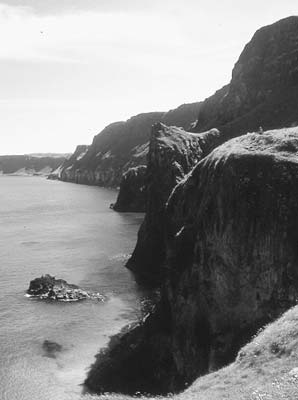
It’s easy to weave these sights together by car, but connections are patchy by public transportation. Bus service is viable only in summer, and taxi fares are reasonable only for the sights closest to Portrush (Dunluce Castle and the Old Bushmills Distillery). For more on your transportation options, see “Getting Around the Antrim Coast,” earlier.
With a car, you can visit the Giant’s Causeway, Old Bushmills Distillery, Carrick-a-Rede Rope Bridge, and Dunluce Castle in one busy day. Call ahead to reserve the Old Bushmills Distillery tour, and get an early start. Arrive at the Giant’s Causeway by 9:00, when crowds are sparse. Park your car in the visitors center lot (opens at 9:00; parking is included with your entry fee). Early birds will find that the trails are free and always open. Spend an hour and a half scrambling over Ireland’s most unique geology.
Then catch a late-morning tour of the Old Bushmills Distillery. Grab a cheap lunch in the hospitality room afterward. A 20-minute drive east brings you to Carrick-a-Rede, where you can enjoy a scenic cliff-top trail hike all the way to the lofty rope bridge (one hour round-trip, 1.5 hours if you cross the rope bridge and explore the sea stack). Hop in your car and double back west all the way to dramatically cliff-perched Dunluce Castle for a late-afternoon tour. From here, you’re only a five-minute drive from Portrush.
Those with extra time, a car, and a hankering to seek out dramatic coastal cliff scenery may want to spend a half-day boating out to Rathlin Island, Northern Ireland’s only inhabited island.
This five-mile-long stretch of coastline, a World Heritage Site, is famous for its bizarre basalt columns. The shore is covered with largely hexagonal pillars that stick up at various heights. It’s as if the earth were offering God his choice of 37,000 six-sided cigarettes.
Geologists claim the Giant’s Causeway was formed by volcanic eruptions more than 60 million years ago. As the surface of the lava flow quickly cooled, it contracted and crystallized into columns (resembling the caked mud at the bottom of a dried-up lakebed, but with deeper cracks). As the rock later settled and eroded, the columns broke off into the many stair-like steps that now honeycomb the Antrim Coast.
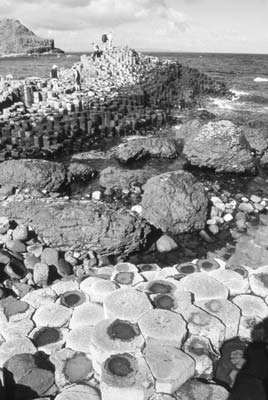
Of course, in actuality, the Giant’s Causeway was made by a giant Ulster warrior named Finn MacCool who knew of a rival giant living on the Scottish island of Staffa. Finn built a stone bridge over to Staffa to spy on his rival, and found out that the Scottish giant was much bigger. Finn retreated back to Ireland and had his wife dress him as a sleeping infant, just in time for the rival giant to come across the causeway to spy on Finn. The rival, shocked at the infant’s size, fled back to Scotland in terror of whomever had sired this giant baby. Breathing a sigh of relief, Finn tore off the baby clothes and prudently knocked down the bridge. Today, proof of this encounter exists in the geologic formation that still extends undersea and surfaces at Staffa.
For cute variations on the Finn story, as well as details on the ridiculous theories of modern geologists, start out in the visitors center. It’s filled with interactive exhibits giving a worthwhile history of the Giant’s Causeway, with a regional overview. On the far wall opposite the entrance, check out the interesting three-minute film showing the evolution of the causeway from molten lava to the geometric, geologic wonderland of today. The large 3-D model of the causeway offers a bird’s-eye view of the region. Some of the exhibits are geared to kids who get a kick out of all things giant-related. A gift shop and cafe are standing by.
Cost and Hours: £8.50 (includes parking), open daily 9:00-19:00; hiking trails free and open from dawn to dusk; tel. 028/2073-1855, www.nationaltrust.org.uk/giantscauseway.
The causeway itself—the highlight of the entire coast—is free and always open. If you pay to enter the visitor’s center, you can borrow a great little audioguide to take along on your hike. Each of the audioguide’s 15 stops displays a photo of the formation being described to help you better recognize each one as you walk; all stops are shown on the map you’ll receive with your ticket.
From the visitors center, you have several options for visiting the causeway:
By Minibus: A minibus (4/hour from 9:00, £1 each way) zips tired tourists a half-mile directly from the visitors center down a paved road and along the tidal zone to the causeway. This standard route (the blue dashed line on your map) offers the easiest access and follows the stops on your audioguide. Some choose to walk down this route to the causeway, and then take the shuttle back up.
By Foot: For a more varied dose of causeway views, consider the cliff-top trail (red dashed line on your map). Take the easy-to-follow trail uphill from the visitors center 10 minutes and catch your breath at Weir’s Snout, the great fence-protected precipice viewpoint. It’s only 15 level minutes farther to reach the Shepherd’s Steps. Then grab the banister on the steep (and slippery on wet days) stairs that zigzag down the switchbacks toward the water. At the T-junction, go 100 yards right, to the towering rock pipes of “the Organ.” (You can walk another 500 yards east around the headland, but the trail dead-ends there.) Now retrace your steps west on the trail (don’t go up the steps again), continuing down to the tidal zone, where the “Giant’s Boot” (6 feet tall, on the right) provides some photo fun. Another 100 yards farther is the dramatic point where the causeway meets the sea. Just beyond that, at the asphalt turnaround, is the bus stop where you can catch a shuttle bus back to the visitors center.
Explore the uneven, wave-splashed rock terraces, watching your every easy-to-trip step. Look for “wishing coins”—rusted and bent—that have been jammed into the cracks of rock just behind the turnaround (where the trail passes through a notch in the 20-foot-high rock wall). With time and energy, you can skip the bus and walk back up to the visitors center, listening to the audioguide at the highlighted stops.
The Full Monty: Hardy hikers can spend a couple of hours exploring the trail that runs along a five-mile section of the Causeway Coast (yellow dashed line on your map). However, occasional rock falls and slides can close this route (ask first at Portrush TI, or call ahead to visitors center). A £1 hiking guide, sold at the TI, points out the highlights named by 18th-century guides (Camel’s Back, Giant’s Eye, and so on).
A good plan is to take the Causeway Rambler bus or a taxi from Portrush to the meager ruins of Dunseverick Castle (east of Giant’s Causeway on B-146). Get off there and hike west, following the cliff-hugging contours of Benbane Head back to the visitors center. Then travel back to Portrush by taxi or Rambler bus (check bus schedules ahead of time at Portrush TI or online at www.translink.co.uk).
Bushmills claims to be the world’s oldest distillery. Though King James I (of Bible fame) only granted Bushmills its license to distill “Aqua Vitae” in 1608, whiskey has been made here since the 13th century. Distillery tours waft you through the process, making it clear that Irish whiskey is triple distilled—and therefore smoother than Scotch whisky (distilled merely twice and minus the “e”).
Cost and Hours: £7.50; April-Oct tours on the half-hour Mon-Sat from 9:30, Sun from 12:00, last tour at 16:00; Nov-March tours Mon-Sat at 10:00, 11:00, 12:00, 13:30, 14:30, and 15:30, Sun from 12:00. To find Bushmills, look for the distillery sign a quarter-mile from Bushmills town center. Tel. 028/2073-3218, www.bushmills.com.
Visiting the Distillery: The 45-minute tour starts with the mash pit, which is filled with a porridge that eventually becomes whiskey. (The leftovers of that porridge are fed to the county’s particularly happy cows.) You’ll see thousands of oak casks—the kind used for Spanish sherry—filled with aging whiskey.
The finale, of course, is the opportunity for a sip in the 1608 Bar—the former malt barn. Visitors get a single glass of their choice. Hot-drink enthusiasts might enjoy a cinnamon-and-cloves hot toddy. Teetotalers can just order tea, totally.
To see the distillery at its lively best, visit when the 100 workers are staffing the machinery—Monday morning through Friday noon (weekend tours see a still still). Stick close to the guide to hear the commentary in this loud environment. Tours are limited to 35 people and book up. In summer, call ahead to put in your name and get a tour time. After the tour, you can get a decent lunch in the tasting room.
For 200 years, fishermen hung a narrow, 90-foot-high bridge (planks strung between wires) across a 65-foot-wide chasm between the mainland and a tiny island. Today, the bridge (while not the original version) gives access to the sea stack where salmon nets were set (until 2002) during summer months to catch the fish turning and hugging the coast’s corner. (The complicated system is described at the gateway.) A pleasant, 30-minute, one-mile walk from the parking lot takes you to the rope bridge. Cross over to the island for fine views and great seabird-watching, especially during nesting season.
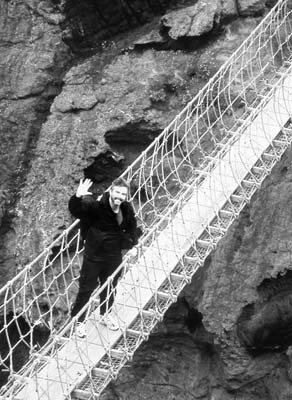
Cost and Hours: £5.60 trail and bridge fee, pay at hut beside parking lot, coffee shop and WCs near parking lot; March-Oct daily 9:30-18:00, June-Aug until 19:00; Nov-Feb 10:00-14:30; tel. 028/2076-9839, www.nationaltrust.org.uk.
Nearby: If you have a car and a picnic lunch, don’t miss the terrific coastal viewpoint rest area one mile steeply uphill and east of Carrick-a-Rede (on B-15 to Ballycastle). This grassy area offers one of the best picnic views in Northern Ireland (picnic tables but no WCs). Feast on bird’s-eye views of the rope bridge, nearby Rathlin Island, and the not-so-distant Island of Mull in Scotland.
These romantic ruins, perched dramatically on the edge of a rocky headland, are a testimony to this region’s turbulent past. During the Middle Ages, the castle resisted several sieges. But on a stormy night in 1639, dinner was interrupted as half of the kitchen fell into the sea, taking the servants with it (Ireland’s first fast food?). That was the last straw for the lady of the castle. The countess of Antrim packed up and moved inland, and the castle “began its slow submission to the forces of nature.”
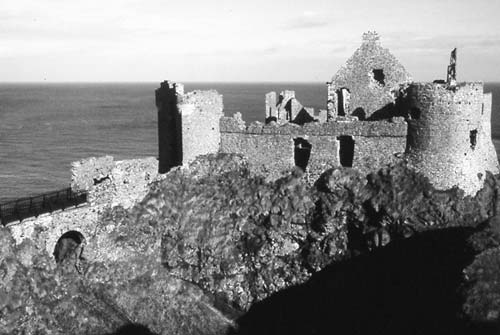
Cost and Hours: £5, daily April-Sept 10:00-17:30, Oct-March 10:00-16:00, last entry 30 minutes before closing, free audioguide, tel. 028/2073-1938.
Visiting the Castle: While it’s one of the largest castles in Northern Ireland and is beautifully situated, there’s precious little left to see among Dunlace’s broken walls.
Before entering, catch the great seven-minute film about the history of the castle (across from the ticket desk). Your entry fee likely will include an impromptu guided tour of the ruins, led by one of the castle’s small stable of dedicated guides. The ruins themselves are dotted with anchored plaques that show interesting artists’ renditions of what the place would have looked 400 years ago. The six-stop audioguide is free and fleshes out the story.
The 16th-century expansion of the castle was financed by the salvaging of a shipwreck. In 1588, the Spanish Armada’s Girona—overloaded with sailors and the valuables of three abandoned sister ships—sank on her way home after the aborted mission against England. More than 1,300 drowned, and only five survivors washed ashore. The shipwreck was excavated in 1967, and a bounty of golden odds and silver ends wound up in Belfast’s Ulster Museum. (The Tower Museum in Derry has a similar collection of Armada artifacts from a different shipwreck farther west.)
The only inhabited island off the coast of Northern Ireland, Rathlin is a quiet haven for hikers, birdwatchers, and seal spotters. Less than seven miles from end to end, this “L”-shaped island is reachable by ferry from the town of Ballycastle.
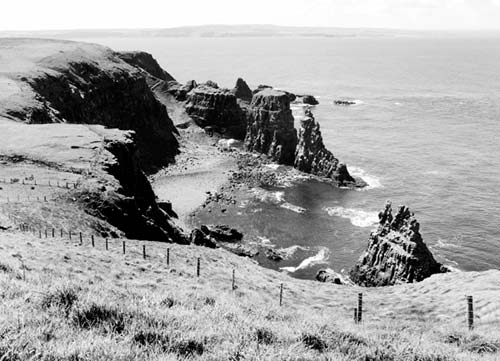
Getting There: The Rathlin Island ferry departs from Ballycastle, just east of Carrick-a-Rede. It does 10 crossings per day in summer. Six are fast 20-minute trips on passenger boats, and four are slower 45-minute trips on car ferries (£12 round-trip per passenger on either type of boat, reserve ahead, tel. 028/2076-9299, www.rathlinballycastleferry.com).
Travelers with rental cars will have no problem reaching Ballycastle. A taxi from Portrush to Ballycastle runs £25 one-way. Bus service from Portrush to Ballycastle is spotty (check with the TI in Portrush, or contact Translink—tel. 028/9066-6630, www.translink.co.uk).
Visiting Rathlin Island: Rathlin’s population of 75 islanders clusters around the ferry dock at Church Bay. Here you’ll find the Rathlin Manor House, offering the island’s most convenient lodging, a restaurant, and a pub (tel. 028/2076-3964, www.rathlinmanorhouse.co.uk). The Rathlin Boathouse Visitor Centre operates as the island’s TI (May-Aug daily 10:30-13:30 & 14:00-16:00, on the bay 100 yards east of the ferry dock, tel. 028/2076-2024).
In summer, the Puffin shuttle bus (£5 round-trip, seats 25) meets arriving ferries and drives visitors to the Rathlin Island Seabird Centre at the west end of the island. Here a lighthouse extends down the cliff with its beacon at the bottom. It’s upside down because the coast guard wants the light visible only from a certain distance out to sea. The bird observation terrace at the center (next to the lighthouse) overlooks one of the most dramatic coastal views in Ireland—a sheer drop of more than 300 feet to craggy sea stacks just offshore that are draped in thousands of sea birds. Photographers will want to bring their most powerful zoom lens.
For such a snoozy island, Rathlin has seen its fair share of history. Flint axe-heads were quarried here in Neolithic times. The island was one of the first in Ireland to be raided by Vikings, in 795. Robert the Bruce hid out from English pursuers on Rathlin in the early 1300s (see “The Scottish Connection” sidebar, earlier). In the late 1500s, local warlord Sorely Boy MacDonnell stashed his extended family on Rathlin and waited on the mainland at Dunluce Castle to face his English enemies...only to watch in horror as they headed for the island instead to massacre his loved ones. And in 1917, a WWI U-boat sank the British cruiser HMS Drake in Church Bay. The wreck is now a popular scuba-dive destination.
Not particularly high (never more than 1,500 feet), the Antrim Mountains are cut by a series of large glens running northeast to the sea. Glenariff, with its waterfalls (especially the Mare’s Tail), is the most beautiful of the nine glens. Travelers going by car can take a pleasant drive from Portrush to Belfast, sticking to the (more scenic but less direct) A-2 road that stays near the coast and takes in parts of all of the Glens of Antrim. The two best stops en route are Cushendall (nice beach for a picnic) and the castle at Carrickfergus (see here).